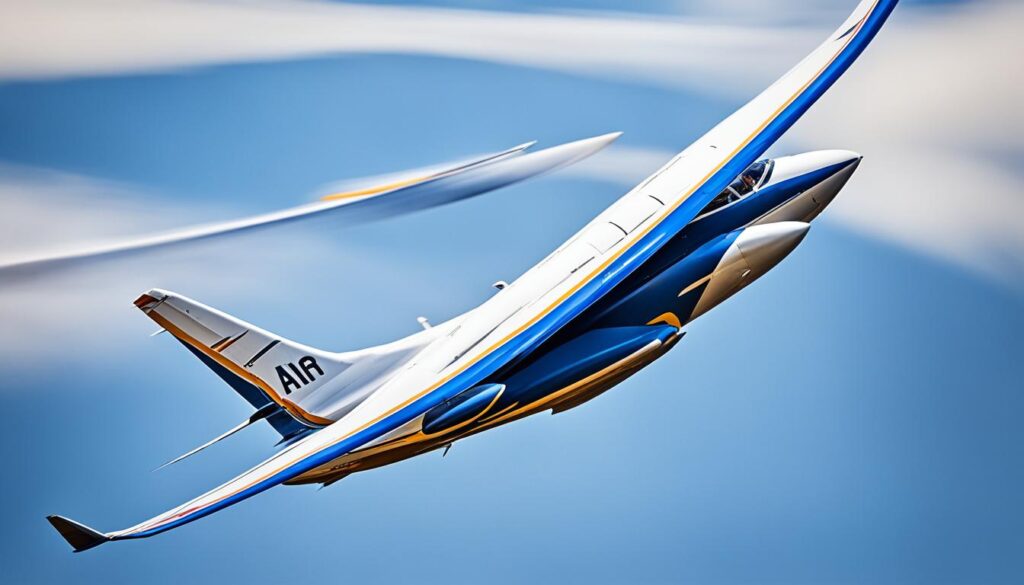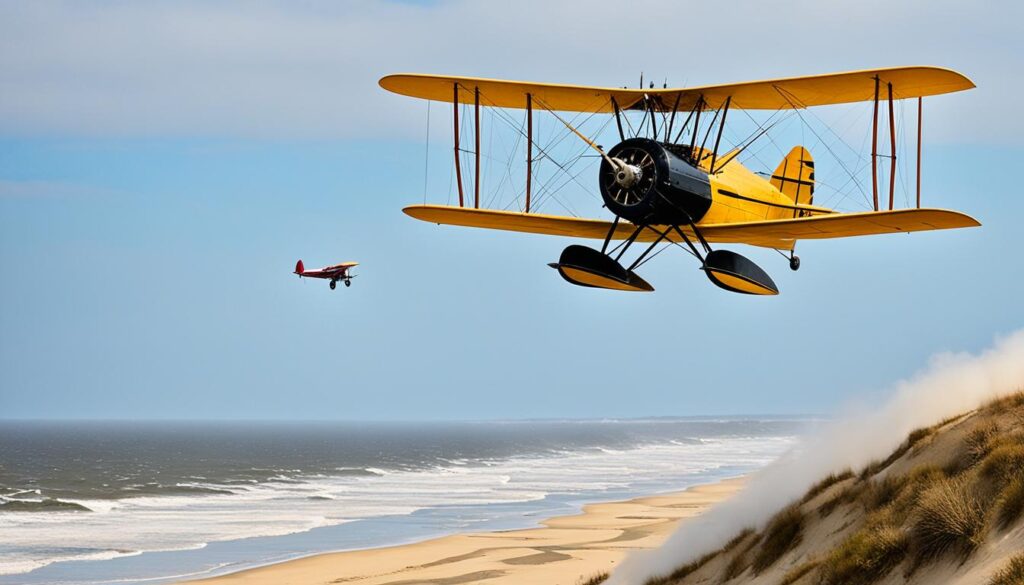The Wright Brothers, Wilbur and Orville Wright, are famous for starting modern aviation. They went from running a bike shop to changing flight history. This story will look at their background, big ideas, and lasting effects. Their work changed how we travel and fly.
Wilbur and Orville Wright were born in Dayton, Ohio, in the late 1800s. They always loved flight and started testing with kites and gliders early on. Their curiosity and boldness led them to big discoveries in aerodynamics. This led to the first powered flight.
The Wright Brothers did deep research to understand flight. They built the Wright Flyer, a key moment in aviation history. Their work, like the wind tunnel and propeller system, helped speed up aviation progress.
The Birth of Aviation Dreams
The Wright Brothers started dreaming of flight as kids, inspired by kites and gliders. They loved the idea of flying on their own. Even when they faced early failures, they didn’t give up. They kept working to understand how to fly.
Childhood Fascination with Flight
Wilbur and Orville Wright grew up in Dayton, Ohio, with a big dream: to fly. They spent hours making kites and studying how birds fly. This early love for flying would change their lives and make them pioneers in aviation.
Early Experiments and Failures
As they got older, the Wright brothers wanted to fly even more. They tried many designs and materials to make powered flight work. They built gliders and used wind tunnels, facing many failures. But they didn’t stop because of these setbacks.
Their dreams and hard work paid off. The Wright brothers changed aviation history. Their early passion and experiments led to amazing achievements in flight.
Unlocking the Secrets of Aerodynamics
The Wright Brothers changed history with their deep dive into aerodynamics and flight mechanics. They spent years researching, experimenting, and analyzing to understand lift, drag, and control. This knowledge was key to their big leaps in aviation science.
They knew that understanding aerodynamics was essential for flying planes. So, they spent hours studying how air moves over different wing shapes. They recorded their findings and kept improving their designs.

One big step was building a wind tunnel. This tool let them test and improve wing designs. By measuring lift and drag forces, they made their wings better. This led to the Wright Flyer, the first powered plane that could fly well.
Their study of flight mechanics helped them beat past flying challenges. They grasped the basics of aerodynamics deeply. This knowledge was vital for their success and helped speed up flying advancements.
The Wind Tunnel: A Groundbreaking Innovation
The Wright Brothers built a wind tunnel to test their ideas. This tool was key to their success in making a flying machine. It let them check how different wing shapes worked, helping them understand flight better.
Designing and Building the Wind Tunnel
The Wright Brothers’ wind tunnel was a work of genius. It was small, only 16 inches wide and 6 feet long, but powerful. It created air flow like in flight, letting them test wing models. This way, they could improve their designs step by step.
Analyzing Wing Shapes and Lift
In their wind tunnel, the Wright Brothers found something amazing. They saw how wing shape affects lift. By testing various wings, they found the best shape for their flying machine. This led to the Wright Flyer, the first powered aircraft to fly.
The Wright Flyer: Engineering Marvel
The Wright Brothers worked hard to create the Wright Flyer. It was a groundbreaking aircraft that had a strong yet light structure and a smart propulsion system. This aircraft was the start of modern flying and led to their famous first flight.
Lightweight yet Sturdy Design
The Wright Brothers knew they needed an aircraft that was both light and strong. They used spruce wood and muslin fabric to make the Wright Flyer’s frame. This made the aircraft strong but also very light.
This new way of designing aircraft helped the Wright Flyer fly and opened doors for future improvements in flying technology.
The Ingenious Propeller System
The Wright Flyer had two special propellers powered by a small gasoline engine. The Wright Brothers designed the propellers with specific angles and sizes. This made the aircraft fly smoothly and steadily.
This propeller system was key to the Wright Flyer’s success and helped the brothers make history at Kitty Hawk.
The Wright Flyer was a result of the Wright Brothers’ hard work, research, and engineering skills. They combined a light yet strong design with a smart propeller system. This made an aircraft that could fly well and started modern aviation.
Educational Outreach and Legacy
The Wright Brothers did more than change aviation. They worked hard to share their knowledge with everyone. They wanted to inspire the next innovators, making a big mark on STEM education.
They knew it was key to spark a love for science and exploration in young people. So, they gave lectures and showed off their new aircraft. They wanted to make the science of flying easy to understand and motivate young minds.
Today, the Wright Brothers’ work still inspires people around the world. Schools and museums use their story to teach science and technology. They show how the Wright Brothers’ hard work and dreams can guide others.
Their legacy is huge, showing how passion and sharing knowledge can change the world. The Wright Brothers’ efforts keep inspiring people to follow their dreams in aviation and STEM fields. Their spirit will keep motivating future generations.
Kitty Hawk: The Historic First Flight
On a cold, windy morning on December 17, 1903, the Wright brothers made history at Kitty Hawk, North Carolina. Wilbur and Orville Wright, the pioneering aviators, successfully completed the first powered, sustained, and controlled airplane flight. This moment changed aviation forever.
The Wright brothers had spent years studying aerodynamics. They built their own wind tunnel and tested gliders. Their hard work led them to this big moment at Kitty Hawk. This place was chosen for its strong winds and soft ground.

A few people saw the first flight, which lasted 12 seconds and went 120 feet. But this short flight started a new era in flying. The Wright brothers’ work led to fast growth in aviation. They inspired many others and became known as the pioneers of flight.
The success at Kitty Hawk showed the Wright brothers’ careful planning and skill. Their work changed aviation and showed what passion and hard work can do. They set a high standard for innovation.
Overcoming Obstacles and Skepticism
The Wright Brothers’ path to flying was not easy. They faced many obstacles and people doubted their dreams. But they didn’t give up. Their hard work, scientific thinking, and ability to bounce back were key to their success.
Getting money was hard for the Wright Brothers. They had to be very creative with what they had. Not having enough money from investors made things even tougher.
Many experts didn’t believe the Wright Brothers could make heavier-than-air flight work. They thought it was impossible. But the brothers proved them wrong with their careful tests and data.
Despite all the challenges, the Wright Brothers kept going. They ignored those who doubted them. Instead, they kept improving their designs and testing their ideas.
The Wright Brothers’ story shows us the strength of determination and scientific thinking. Their hard work changed aviation forever. It inspired others to dream big and try new things.
The Birth of Modern Aviation
The Wright Brothers started a new chapter in aviation history. Their work led to fast growth in aviation technology. Their invention changed how we travel and affected military strategies.
Airplanes soon became key in wars, changing combat and strategy. This marked a big shift in warfare.
Impact on Transportation and Warfare
The Wright Flyer’s first flights opened a new era in air travel. This led to big improvements in aircraft design and engineering. Planes became more reliable and changed how we move people and goods around the world.
They cut travel times and made the world more connected. At the same time, the military saw how valuable airpower was. This led to a quick growth of military aviation in battles.
Inspiring Future Innovators
The Wright Brothers’ work still motivates people to explore flight and space. Their story shows the importance of hard work, creativity, and never giving up. Their legacy has driven many to start their own adventures in discovery and innovation.






